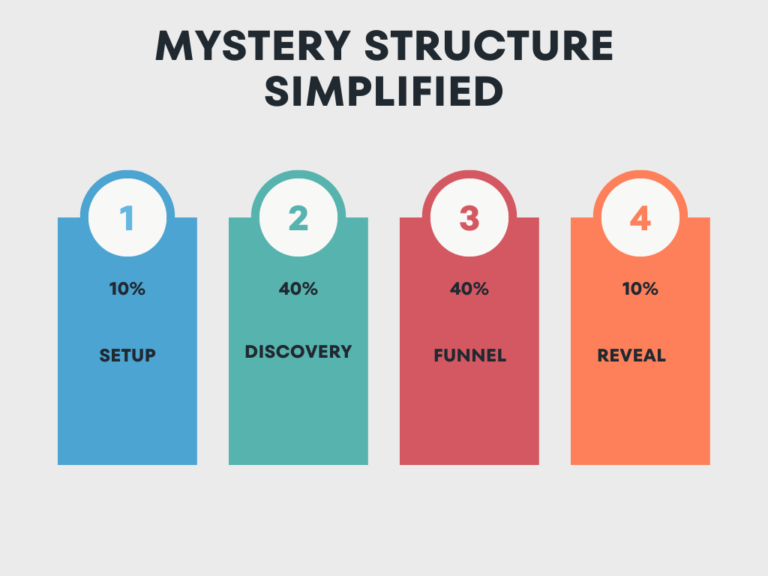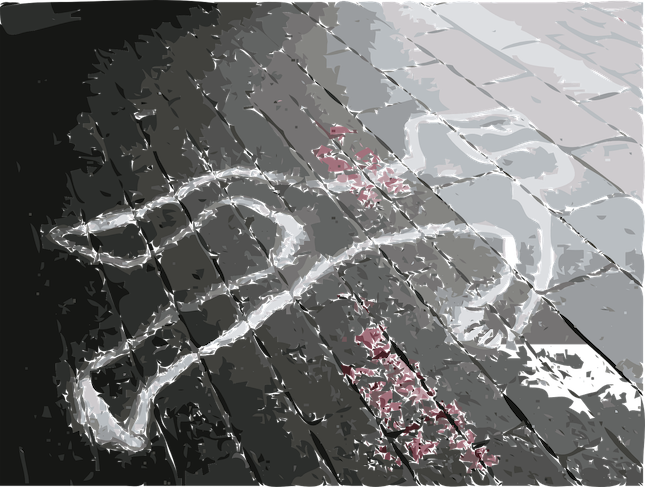The Detective Discovers the Victim’s World: Act 2 of the 4-Act Mystery

Charting Uncharted Territory
As mystery writers, we know that the allure of a mystery novel lies not only in its ultimate resolution but in the intricate journey our detective undertakes to get there. One of the most compelling parts of this journey is when our detective steps into the victim’s world—a world that reveals much more than it conceals.
In the second act of a four-act story structure, the detective’s investigation of the victim’s life goes beyond merely driving the plot. It becomes a compelling journey into uncharted territory, providing profound insights and deepening engagement with the narrative. It’s where they gather bits and pieces of crucial information, meet suspects in their own environments, and expand their understanding of the victim and the case.
But this journey is far from straightforward. As our detective delves deeper, they discover layers and complexities within the victim’s world that were not apparent at first glance. Each new piece of information brings them closer to an unexpected truth, turning initial assumptions on their head.
Entering The Victim’s World
As mystery writers, transitioning from Act I to Act II is a critical point in your narrative structure. It’s the moment when your detective, and consequently your readers, dive deep into the victim’s world—a new, unexplored environment filled with clues and complexities. This phase sets the stage for the profound discoveries and relentless pursuit that will drive your story forward.
Initial Exploration
The victim’s world is the detective’s new landscape, an intricate tapestry woven with the threads of the victim’s life, relationships, and secrets. This world initially appears straightforward, but as your detective delves deeper, hidden layers and unexpected facets begin to surface. Understanding the significance of this world is crucial; it’s not just a setting but a character in its own right, influencing every action, reaction, and revelation that follows.
When your detective first steps into this world, they may feel confident that they understand the basics. However, each new encounter and piece of information quickly reveals there’s more beneath the surface. This initial exploration phase is about setting the stage and piquing curiosity—both for your detective and your readers.
Methods of Gathering Information
In the victim’s world, your detective must employ a variety of methods to gather crucial insights. This involves:
- Observations: The detective notes everything from the arrangement of personal items to the emotional atmosphere in the victim’s home.
- Interviews: Conversations with suspects, witnesses, and acquaintances provide valuable information and often introduce new elements to the case.
- Environmental Scan: Understanding the victim’s daily routines and the places they frequented helps piece together a comprehensive view of their life.
- Document Analysis: Reviewing personal documents, such as letters, emails, diaries, and financial records, uncovers hidden aspects of the victim’s world.
These methods aren’t just about collecting data; they’re about understanding the context and intricacies of the victim’s life. Each method adds depth to the narrative, creating a richer, more immersive story.
Suspects and Allies
As your detective navigates the victim’s world, they’ll inevitably meet new characters. These encounters can range from suspects to potential allies, each bringing their own perspectives and secrets.
1. Suspects in Their Environment: Meeting suspects in their own space helps the detective observe subtle clues that may not be evident in a neutral setting. Each interaction is a potential minefield, filled with half-truths and deliberate misdirections.
2. Allies and Informants: Allies, whether they are friends of the victim or individuals with their own motives, provide the detective with critical information or assistance. However, distinguishing helpful allies from those with hidden agendas adds another layer of complexity.
Through these interactions, your detective’s understanding of the victim’s world expands, and the narrative tension builds. Craft each new discovery and character interaction to keep the readers engaged, driving them to turn the pages in anticipation of what comes next.
Expanded Understanding
As the detective gathers information and interacts with suspects and allies, their understanding of the victim’s world doesn’t just expand—it transforms. What seemed like simple facts at first, become pieces of a much larger, more intricate puzzle.
The detective learns to see beyond the surface, recognizing patterns and connections that were initially hidden. This growing awareness drives the story forward and sets the stage for the unexpected twists and turns that lie ahead.
Through meticulous exploration of the victim’s world, you skillfully guide your detective, ensuring an engaging and immersive narrative that keeps readers captivated. It’s this depth of understanding and attention to detail that captures the readers’ imagination, making the journey as exciting as the destination.
Expand the Mystery Story – Introduce Subplots in Act 2
Subplots are essential threads that add richness and complexity to your main storyline. In Act 2, as your detective delves deeper into the victim’s world, these secondary narratives provide additional layers of intrigue, tension, and emotional depth. Imagine subplots as the intricate patterns in a tapestry that, when woven together, create a more vibrant and captivating picture.
Types of Subplots
1. Personal Struggles:
– Your detective might face personal challenges that run parallel to the main mystery. These could involve relationships with family, romantic interests, or grappling with their own internal demons.
– For instance, while solving the case, your detective may also be dealing with a strained relationship with a loved one, adding emotional stakes to their journey.
2. Romantic Entanglements:
– Introducing a romantic subplot can heighten the tension and offer moments of respite. It can also serve as a mirror to the main plot, reflecting its themes and conflicts.
– A romantic interest might become entangled in the investigation, providing pivotal clues or complicating the detective’s pursuit of truth.
3. Rivalries and Alliances:
– Your detective might encounter professional rivalries or form alliances that impact the main investigation. These relationships can be fraught with tension and competition, adding another layer to the narrative.
– A rival detective or a dubious ally can introduce new conflicts or red herrings that keep your readers guessing.
4. Moral Dilemmas:
– Present your detective with moral or ethical quandaries that challenge their beliefs and values. These subplots can deepen the character’s development and add psychological complexity to the story.
– For example, your detective might have to choose between following legal procedures and pursuing a personal sense of justice, risking their career or reputation.
Seamless Subplots
1. Link to the Main Plot:
– Ensure your subplots have a clear connection to the main mystery. This integration makes the subplots feel essential rather than extraneous.
– For instance, a romantic interest might inadvertently provide crucial information about the case, or a personal struggle might reveal a key insight about the victim’s world.
2. Balance Screen Time:
– Carefully balance the time dedicated to subplots and the main plot. Subplots should enhance, not overshadow, the central narrative.
– Alternate between progressing the main plot and exploring subplots, maintaining a rhythm that keeps readers engaged and invested in all aspects of the story.
3. Build Tension:
– Use subplots to build tension and suspense. Each subplot should introduce its own set of conflicts and stakes, contributing to the overall momentum of the narrative.
– As the detective faces setbacks in the main investigation, subplots can provide additional challenges or moments of breakthrough that enrich the story.
Payoff for Subplots
1. Midpoint Revelations:
– Subplots should reach significant turning points around the midpoint of your story. These revelations intersect with the main plot, adding dramatic impact and keeping readers on their toes.
– A subplot might reveal a hidden aspect of the victim’s world, providing a crucial clue that propels the main plot forward.
2. Character Development:
– Use subplots to deepen your characters. The challenges and relationships explored in these side stories can reveal new facets of your detective’s personality and motivations.
– As your detective navigates personal struggles and alliances, they grow and evolve, making them more relatable and compelling to readers.
3. Resolution and Confluence:**
– Ensure that subplots are resolved in a satisfying manner before the end of the story, preferably intertwining with the resolution of the main plot.
– The resolution of a romantic tension or the conclusion of a moral dilemma should complement the main narrative’s climax, providing a cohesive and gratifying ending for your readers.
By skillfully incorporating subplots in Act 2, you establish a complex narrative that captivates audiences with its depth of detail and emotionally charged storytelling.These secondary stories add depth and complexity, ensuring that your readers remain captivated and curious, eager to uncover not just the mystery at hand but the intricate lives and struggles of the characters involved.
Discover the Depth
Sequence of Discoveries
You know that each layer peeled back in the victim’s world reveals more complexities and nuances. This sequence of discoveries is crucial. Your detective will think they have a grasp on the situation, only to find that each new piece of information leads to further questions and deeper intrigue.
Focus on creating a rhythm to these discoveries. Each revelation should feel like a step deeper into an intricate web, gradually unfolding the true nature of the mystery. This structure helps maintain momentum and keeps your readers engaged, eager to see what lies beneath the surface.
Engagement with Suspects and Allies
In this phase, your detective’s interactions with suspects and allies become even more significant. Here are some strategies to deepen these engagements:
1. Build Complexity with Suspects:
– Allow your detective to engage suspects in their natural environments. This approach helps reveal hidden facets of their personalities and possible motivations.
– Through conversations and observations, your detective can pick up on inconsistencies and subtle clues that wouldn’t be apparent in a neutral setting.
2. Leverage Allies for Insight and Conflict:
– Allies can provide invaluable insights and assistance, but they can also introduce conflict and complication. Make sure your detective distinguishes helpful allies from those with hidden agendas.
– These interactions should add to the narrative rather than solve it outright, maintaining a balance between assistance and challenges.
3. Develop Meaningful Relationships:
– Relationships between your detective and the characters they meet should feel authentic and develop over time. Whether it’s a growing trust or mounting suspicion, these dynamics can add richness to your story.
Expand Understanding
As your detective navigates this sea of discovery, their understanding of the victim’s world will continuously expand and transform. The initial impressions they had are now evolving into a more intricate and interconnected web of details.
1. Reveal Hidden Layers:
– Every new piece of information should feel like pulling back a curtain, revealing new complexities and surprises about the victim’s life.
– Ensure these revelations are paced well, allowing your readers to absorb the significance of each one before moving on to the next.
2. Recognize Patterns and Connections:
– Your detective should begin to notice patterns and connections that were previously hidden. This growing awareness is crucial for building the bigger picture of the mystery.
– Encourage your detective to question their assumptions and look at the evidence from different angles. This broader perspective adds depth to your narrative.
3. Increase Narrative Tension:
– Each discovery adds to the narrative tension. Ensure that your detective’s deep dive into the victim’s world keeps your readers on the edge of their seats.
– This tension should build steadily, leading to pivotal moments that drive the story forward.
Build Toward a Turning Point
As your detective delves deeper into the victim’s world, they are inevitably building toward a significant turning point at the Midpoint. This pivotal moment often reframes their understanding of the case and sets the stage for the ensuing drama.
1. Prepare for the Midpoint:
– Your sequence of discoveries should naturally lead to the midpoint of your story, a high-stakes moment that fundamentally shifts the narrative.
– Ensure this buildup feels organic, with each piece of the puzzle falling into place right up to this crucial juncture.
2. Create Impactful Revelations:
– The revelations made during this phase should have a significant impact, reshaping the detective’s approach and highlighting the complexity of the victim’s world.
– These moments of clarity can be both rewarding for the detective and startling for your readers, maintaining engagement and excitement.
Through the lens of these crucial elements, your detective’s journey through the victim’s world becomes an immersive and captivating experience. Each discovery, interaction, and realization helps to build a narrative that deeply engages your readers and paves the way for dramatic twists and turns.
Keep Your Readers Guessing
As mystery writers, your goal is to take your readers on an unforgettable journey through the labyrinthine depths of the victim’s world. From the moment your detective first steps into this new realm, they are on a quest for discovery, peeling back layers of secrets and uncovering clues that were initially hidden in plain sight.
Take your time. Don’t rush toward the end. In Act 2 of the 4-Act Structure, you are building question after question to keep your reader guessing.
In the early stages, the detective’s entry into the victim’s world sets the stage. By methodically gathering information and meeting suspects and allies, your story gains richness and depth. This phase is all about establishing a rhythm of discovery that keeps readers eagerly turning the pages.
As your detective dives deeper into the victim’s world, they encounter more complexities and unveil hidden layers. Each interaction, whether with suspects or allies, adds to the intricate web of your narrative. The detective’s growing understanding drives the story forward, creating a compelling momentum that heightens the narrative tension.
Navigating the maze of discoveries, your detective faces pivotal moments and turning points. These transformative experiences not only reshape the detective’s approach but also lead to dramatic revelations. By the time your story reaches the midpoint, your readers should be fully immersed, eagerly questioning who the perpetrator might be and anticipating the thrilling conclusion and revelation.
The discovery process is your primary tool to keep readers guessing. Each new piece of the puzzle should not only add to the narrative but also introduce new questions and uncertainties. By skillfully building toward the midpoint, you create a high-stakes, high-drama moment that leaves your readers eager to find out what happens next.
Your meticulous guidance steers your detective through uncharted territories, shaping a compelling mystery that captivates with its intricate details and masterful execution. Your readers won’t just be reading to solve the mystery—they’ll be savoring every step of the journey, captivated by the intricate dance of discovery that keeps them guessing until the very end.
Wondering what to do next with your mystery? Get past your stuck point. Connect on the Power Hour.






